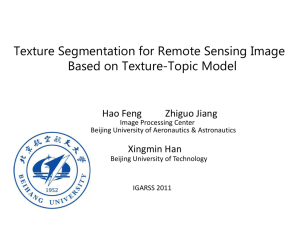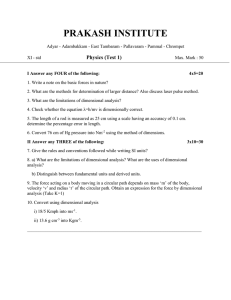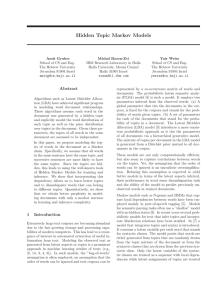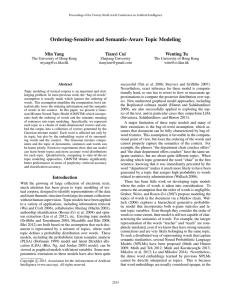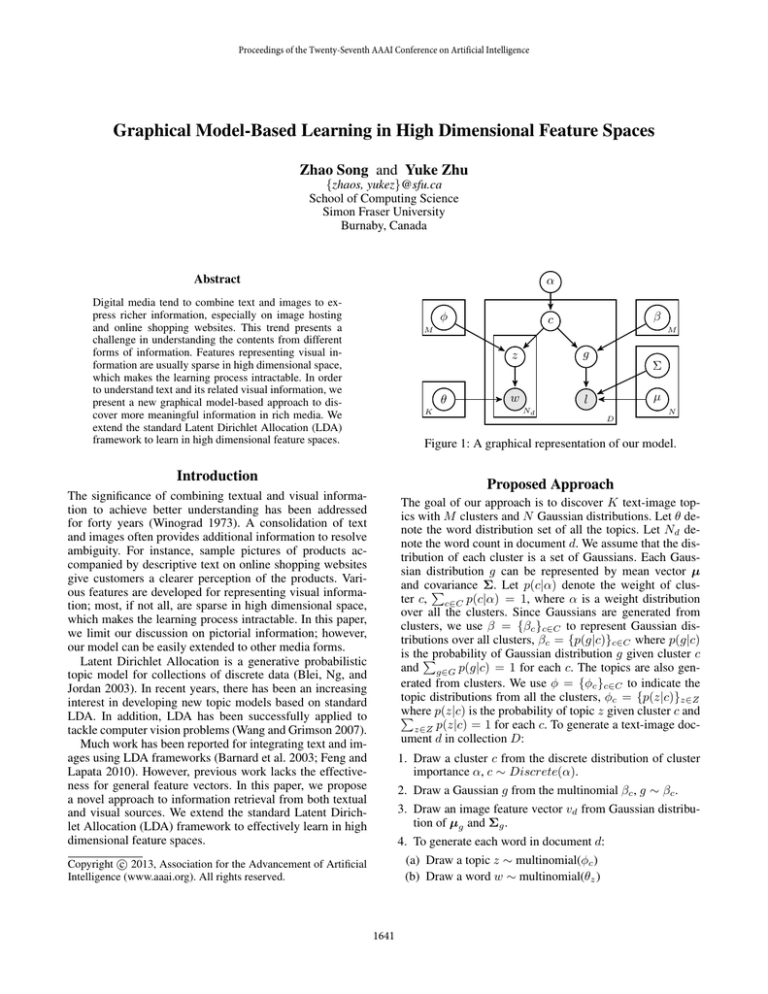
Proceedings of the Twenty-Seventh AAAI Conference on Artificial Intelligence
Graphical Model-Based Learning in High Dimensional Feature Spaces
Zhao Song and Yuke Zhu
{zhaos, yukez}@sfu.ca
School of Computing Science
Simon Fraser University
Burnaby, Canada
Abstract
α
Digital media tend to combine text and images to express richer information, especially on image hosting
and online shopping websites. This trend presents a
challenge in understanding the contents from different
forms of information. Features representing visual information are usually sparse in high dimensional space,
which makes the learning process intractable. In order
to understand text and its related visual information, we
present a new graphical model-based approach to discover more meaningful information in rich media. We
extend the standard Latent Dirichlet Allocation (LDA)
framework to learn in high dimensional feature spaces.
φ
β
c
M
M
g
z
θ
K
Σ
w
µ
l
Nd
N
D
Figure 1: A graphical representation of our model.
Introduction
Proposed Approach
The significance of combining textual and visual information to achieve better understanding has been addressed
for forty years (Winograd 1973). A consolidation of text
and images often provides additional information to resolve
ambiguity. For instance, sample pictures of products accompanied by descriptive text on online shopping websites
give customers a clearer perception of the products. Various features are developed for representing visual information; most, if not all, are sparse in high dimensional space,
which makes the learning process intractable. In this paper,
we limit our discussion on pictorial information; however,
our model can be easily extended to other media forms.
Latent Dirichlet Allocation is a generative probabilistic
topic model for collections of discrete data (Blei, Ng, and
Jordan 2003). In recent years, there has been an increasing
interest in developing new topic models based on standard
LDA. In addition, LDA has been successfully applied to
tackle computer vision problems (Wang and Grimson 2007).
Much work has been reported for integrating text and images using LDA frameworks (Barnard et al. 2003; Feng and
Lapata 2010). However, previous work lacks the effectiveness for general feature vectors. In this paper, we propose
a novel approach to information retrieval from both textual
and visual sources. We extend the standard Latent Dirichlet Allocation (LDA) framework to effectively learn in high
dimensional feature spaces.
The goal of our approach is to discover K text-image topics with M clusters and N Gaussian distributions. Let θ denote the word distribution set of all the topics. Let Nd denote the word count in document d. We assume that the distribution of each cluster is a set of Gaussians. Each Gaussian distribution g can be represented by mean vector µ
and covariance
Σ. Let p(c|α) denote the weight of clusP
ter c, c∈C p(c|α) = 1, where α is a weight distribution
over all the clusters. Since Gaussians are generated from
clusters, we use β = {βc }c∈C to represent Gaussian distributions over all clusters, βc = {p(g|c)}c∈C where p(g|c)
is thePprobability of Gaussian distribution g given cluster c
and g∈G p(g|c) = 1 for each c. The topics are also generated from clusters. We use φ = {φc }c∈C to indicate the
topic distributions from all the clusters, φc = {p(z|c)}z∈Z
where
p(z|c) is the probability of topic z given cluster c and
P
z∈Z p(z|c) = 1 for each c. To generate a text-image document d in collection D:
1. Draw a cluster c from the discrete distribution of cluster
importance α, c ∼ Discrete(α).
2. Draw a Gaussian g from the multinomial βc , g ∼ βc .
3. Draw an image feature vector vd from Gaussian distribution of µg and Σg .
4. To generate each word in document d:
(a) Draw a topic z ∼ multinomial(φc )
(b) Draw a word w ∼ multinomial(θz )
c 2013, Association for the Advancement of Artificial
Copyright Intelligence (www.aaai.org). All rights reserved.
1641
Let us denote all parameters by Ψ = {θ, α, β, φ, µ, Σ}.
Given the data collection {(wd , vd )}d∈D , where wd is the
text and vd is the feature vector of the image, the loglikelihood of the collection given Ψ can be defined as follows:
L(Ψ; D) = log p(D|Ψ) = log
Y
use a difference-of-Gaussian (DoG) detector to identify interesting local points, and compute the Scale-Invariant Feature Transform (SIFT) descriptors for these points. In order
to generate the codebook, we quantize the feature vectors
using k-means clustering. The cluster centroids constitute a
visual word codebook V of size k. Each feature vector is
affiliated to the closest centroid in L2 norm. Thus, we represent an image as a sparse histogram H over V, where the i-th
component of H is occurrence frequency of the i-th visual
word over the total word counts of the image.
p(wd , vd |Ψ)
d∈D
To compare the topics in these clusters, we compute
p(z|v) for topic z ∈ Z given vector v. Given the estimated
Ψ, we first estimate the probability of vector v given topic z.
XX
p(v|z, Ψ) =
p(v|g, Ψ)p(g|c, Ψ)p(c|z, Ψ)
Model Evaluations
Experimental Datasets
We evaluate our approach on two real-life datasets containing textual and visual information. Social20 is an image collection of 20 visual concepts (Li, Snoek, and Worring 2010), which is obtained by randomly selecting 1,000
images for each concept from the image hosting website
Flikr.com. We select all the images with complete metadata
(user tags, titles, descriptions and geographic information)
from five broad concepts for evaluation. Attribute Discovery Dataset is an image dataset with four shopping categories (Berg, Berg, and Shih 2010). This dataset is collected
from the shopping comparison website like.com. Textual descriptions of product sample pictures are provided.
c∈C g∈G
=
XX
c∈C g∈G
where p(z|Ψ) =
P
p(z|c)p(c|α)
p(v|µg , σg )p(g|c, Ψ)
p(z|Ψ)
p(z|c)p(c|α) and p(v|µg , σg ) is based
c∈C
on step 3 in generative process. After we get p(v|z, Ψ),
p(z|v, Ψ) can be computed by Bayes’ law.
p(z|v, Ψ) ∝ p(v|z, Ψ)p(z|Ψ)
X
X
∝
p(z|c)p(c|α)
p(v|g)p(g|c)
c∈C
g∈G
We omit the EM steps due to space constraints. The parameter estimation algorithm is discussed in the Appendix1 .
Our model is based on the assumption that correlation exists between text and its associated visual information: correlated text in the documents tends to accompany with similar visual features. Figure 1 is a graphical representation of
the proposed model.
Experimental Setup
We compare our proposed model against two baseline methods. The first baseline is the standard text-based LDA using
the textual information from metadata. In the second baseline, we regularize the LDA with image feature vectors. We
perform 5-fold cross-validation, and use perplexity to evaluate the performance of these models. In the experiment,
we report three types of perplexity: textual perplexity, visual
perplexity and combined perplexity (see Appendix).
Dimension Reduction
High dimensionality in the representations of rich media often brings difficulty in the learning process. We need dimension reduction techniques to map high dimensional representations into a lower dimensional feature space. In addition, we want to maintain a certain order of the components in the lower dimensional vector for our subsampling
procedure. We use Principal Component Analysis (PCA),
which uses linear transformation for the dimension reduction. The transformation of PCA is well defined such that
the first component in the low dimensional representation
has the greatest variance, the second component has the second greatest variance, and so forth. Thus, PCA allows us to
subsample the first k components with the greatest variance.
Since the optimal k that truncates noisy components is latent, it is optimized by perplexity-based gradient descent in
the learning process.
References
Barnard, K.; Duygulu, P.; Forsyth, D.; de Freitas, N.; Blei, D. M.;
and Jordan, M. I. 2003. Matching words and pictures. Journal of
Machine Learning Research 3:1107–1135.
Berg, T. L.; Berg, A. C.; and Shih, J. 2010. Automatic attribute
discovery and characterization from noisy web images. European
Conference on Computer Vision 663–676.
Blei, D. M.; Ng, A. Y.; and Jordan, M. I. 2003. Latent dirichlet
allocation. Journal of Machine Learning Research 3:993–1022.
Feng, Y., and Lapata, M. 2010. Visual information in semantic
representation. Human Language Technologies: The 2010 Annual
Conference of the North American Chapter of the ACL 91–99.
Li, F.-F., and Perona, P. 2005. A bayesian hierarchical model for
learning natural scene categories. IEEE Computer Vision and Pattern Recognition 524–531.
Li, X.; Snoek, C. G. M.; and Worring, M. 2010. Unsupervised
multi-feature tag relevance learning for social image retrieval.
ACM International Conference on Image and Video Retrieval.
Wang, X., and Grimson, E. 2007. Spatial latent dirichlet allocation.
Neural Information Processing Systems 1–8.
Winograd, T. 1973. A procedural model of language understanding. Computer Models of Thought and Language.
Image Representation
We use a bag-of-words approach (Li and Perona 2005) for
image representation. Each image is treated as a visual document that can be integrated into our graphical models. We
1
Please see Appendix for further explanation: http://www.sfu.
ca/∼zhaos/pub/aaai2013 appendix.pdf
1642



